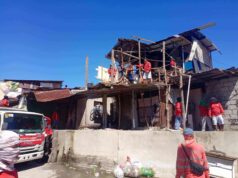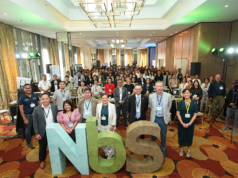SMALL TOWN urbanism.
Barrio urbanidad, the city ethos transplanted to the rustic village? It sounded like a new philosophy too, the first time I heard the phrase from Normandy Canlas, foremost Kapampangan architect and my long-time espresso mate at La Nilad, SM City Pampanga.
“It’s my advocacy, it’s the core value of my practice,” said the man from Minalin, which happened to be closest neighbor to my hometown of Sto. Tomas.
Normandy laments the total absence of holistic planning in the drive to develop the rural areas. Which, as often, results to “infrastructural monstrosities” and urban blight.
“A sense of balance, of symbiosis must be the overriding principle to development. Utmost care must be taken to balance things, to avoid the mistakes of urbanization,” said he, making me like a dutiful student listening to a very interesting professorial lecture. But of course, Normandy having taught for a time at the University of the Assumption’s College of Architecture.
“It is high time for a shift in the development paradigm, with policies and practices thoroughly restructured. We can begin with neighborhoods being diverse in use and population; communities designed equally for pedestrian, public and private transits. All this in keeping with the socio-economic and cultural diversity of the residents.”
How about the green element to living? Asked environmental me.
“Planning for both cities and towns should incorporate physically defined and universally accessible public spaces and community institutions, the green component integrated there. Urban places need to be framed by architecture and landscape designs that do not only conform to climate and the ecology but also celebrate local history and culture.”
Flashed in my mind there were visions of Mayor Oscar S. Rodriguez’s City of San Fernando as the “Habitat for Human Excellence,” by 2030, as projected.
How about the impact of frenzied housing development in Pampanga, where former ricelands and sugarlands, even wetlands are being converted for residential, commercial and industrial uses?
“Land use policies in Pampanga should be guided by this basic principle of maximizing the assets and sustaining economic growth without radically altering the character of the place or the lifestyle of the Kapampangan and the environment.”
Perhaps, you need to talk to your cabalen the governor and give him some inputs in this regard. Normandy simply shrugged off my suggestion, and continued with my lessons.
“My work philosophy is this: In a world of limited resources, an architect has to focus on the essentials that can add value to homes, the community and the environment.”
No environmentally degrading “destroy-in-order-to-build” mindset for this architect.
“I am a strong advocate of environmental preservation. I am frustrated by the disregard of government planners for the environmental element in infrastructure designs. Look at those monstrous flyovers. Had architects been involved in the design, those flyovers could have been architectural marvels with enough flora for both aesthetic and ecological purposes, instead of being arid, ugly concrete jungles.”
Okay, well taken. You have made some beautiful edifices that added aesthetic value to the City of San Fernando, like the HSBC building, Chevrolet Pampanga, and the Guagua Rural Bank Corporate Plaza, to name just three. How about one great architectural wonder you’d like to do?
“Rice terraces ala Banaue on the denuded portion of Mount Arayat, even as the rest of the area is reforested.”
Wow, the melding of the cultural and the ecological there. Perfect symbiosis.
Yeah, as an architect of the first order, Normandy can last.
Barrio urbanidad, the city ethos transplanted to the rustic village? It sounded like a new philosophy too, the first time I heard the phrase from Normandy Canlas, foremost Kapampangan architect and my long-time espresso mate at La Nilad, SM City Pampanga.
“It’s my advocacy, it’s the core value of my practice,” said the man from Minalin, which happened to be closest neighbor to my hometown of Sto. Tomas.
Normandy laments the total absence of holistic planning in the drive to develop the rural areas. Which, as often, results to “infrastructural monstrosities” and urban blight.
“A sense of balance, of symbiosis must be the overriding principle to development. Utmost care must be taken to balance things, to avoid the mistakes of urbanization,” said he, making me like a dutiful student listening to a very interesting professorial lecture. But of course, Normandy having taught for a time at the University of the Assumption’s College of Architecture.
“It is high time for a shift in the development paradigm, with policies and practices thoroughly restructured. We can begin with neighborhoods being diverse in use and population; communities designed equally for pedestrian, public and private transits. All this in keeping with the socio-economic and cultural diversity of the residents.”
How about the green element to living? Asked environmental me.
“Planning for both cities and towns should incorporate physically defined and universally accessible public spaces and community institutions, the green component integrated there. Urban places need to be framed by architecture and landscape designs that do not only conform to climate and the ecology but also celebrate local history and culture.”
Flashed in my mind there were visions of Mayor Oscar S. Rodriguez’s City of San Fernando as the “Habitat for Human Excellence,” by 2030, as projected.
How about the impact of frenzied housing development in Pampanga, where former ricelands and sugarlands, even wetlands are being converted for residential, commercial and industrial uses?
“Land use policies in Pampanga should be guided by this basic principle of maximizing the assets and sustaining economic growth without radically altering the character of the place or the lifestyle of the Kapampangan and the environment.”
Perhaps, you need to talk to your cabalen the governor and give him some inputs in this regard. Normandy simply shrugged off my suggestion, and continued with my lessons.
“My work philosophy is this: In a world of limited resources, an architect has to focus on the essentials that can add value to homes, the community and the environment.”
No environmentally degrading “destroy-in-order-to-build” mindset for this architect.
“I am a strong advocate of environmental preservation. I am frustrated by the disregard of government planners for the environmental element in infrastructure designs. Look at those monstrous flyovers. Had architects been involved in the design, those flyovers could have been architectural marvels with enough flora for both aesthetic and ecological purposes, instead of being arid, ugly concrete jungles.”
Okay, well taken. You have made some beautiful edifices that added aesthetic value to the City of San Fernando, like the HSBC building, Chevrolet Pampanga, and the Guagua Rural Bank Corporate Plaza, to name just three. How about one great architectural wonder you’d like to do?
“Rice terraces ala Banaue on the denuded portion of Mount Arayat, even as the rest of the area is reforested.”
Wow, the melding of the cultural and the ecological there. Perfect symbiosis.
Yeah, as an architect of the first order, Normandy can last.



